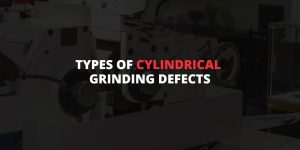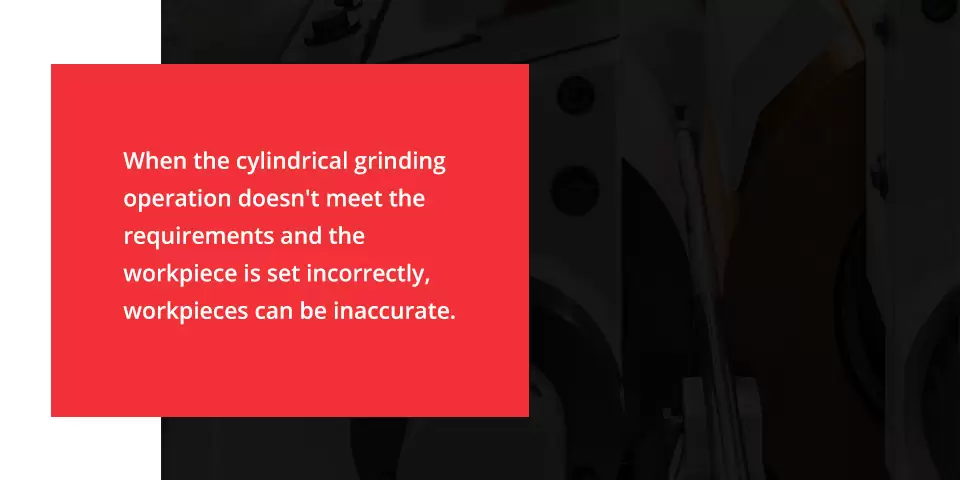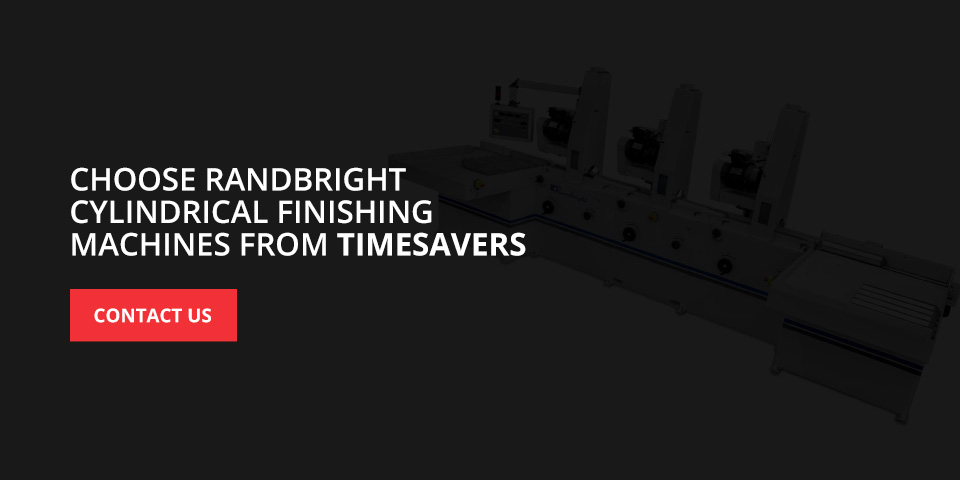Types of Cylindrical Grinding Defects

An essential step in many manufacturing processes is cylindrical grinding, the process of using abrasive grinding to remove material from a workpiece. Various industries use cylindrical grinding machines, from automotive and aerospace to military and information technology. These machines shape pieces like cylinders, pistons and pins to suit the desired form and function.
Although cylindrical grinding machines are helpful and simplistic, problems can still occur during manufacturing. Preventing grinding problems is critical for ensuring production accuracy and avoiding damage to the cylindrical grinding machine.
Below are the most common grinding defects and how you can solve them.
1. Workpiece Is Burnt or Cracked
Burnt and cracked workpieces are two common grinding defects that can produce inaccurate work. Grinding burn is when a workpiece receives thermal damage from an incorrect grinding process that releases excessive heat into the workpiece. This occurrence simulates the tempering process on the material. The piece can crack if the part experiences a high enough level of force. Grinding burn may also cause mechanical part failure.
Fortunately, manufacturers can take several steps to prevent grinding burn and cracking. The solutions for a burnt or cracked workpiece include:
- Use an adequate amount of cooling lubricant: A sufficient supply of cooling lubricant in the grinding zone is vital for preventing grinding burn. The coolant jet stream should have 30-50% of the circumferential speed of the grinding wheel.
- Ensure the wheel abrasiveness suits the material: Select a softer grade wheel or one with a more open structure to avoid putting too much tensile stress on the workpiece.
- Balance the wheel: An imbalanced wheel could grind parts on the workpiece unevenly. Check the balancing stand level to determine whether you need to balance the wheel.
- Improve the grinding operation: High infeed of the workpiece and material removal rate could also lead to grinding burn. Try reducing the wheel infeed rate and increasing the wheel traverse rate.
2. Grinder Is Making Noise
When the grinder starts making noise, this is called chatter. Chatter can be challenging to detect and is often only noticeable during an inspection of your cylindrical grinding machine. Often, chatter appears as visible, regularly-spaced wave marks on the workpiece and indicates a vibration issue.
The wavelength of these marks can indicate specific problems that are to blame:
- Long wavelengths: Work speeds that are too high could create long wavelengths along the workpiece.
- Smaller wavelengths: Lower work speeds might lead to smaller waves.
If you notice chatter during your cylindrical grinding operation, it might be due to one of these common causes:
- Heavy grinding wheel: If the wheel is too heavy for the material, slow down your infeed or traverse feed.
- Hard grinding wheel: Use a softer wheel or decrease the wheel spindle to make the wheel act softer.
- Vibrating machine: Ensure the blade is clamped correctly, rebalance the wheel and check to see whether you need to replace the belt.
- Wheel flanges: If the vibration frequency is the same as the rotation speed of the grinding spindle, the issue is probably with the wheel flanges or grinding spindle. Try tightening the wheel flanges or adjusting the spindle bearings.

3. Workpiece Inaccuracy
Cylindrical grinding requires high precision for accurate grinding. When the cylindrical grinding operation doesn’t meet the requirements and the workpiece is set incorrectly, workpieces can be inaccurate. The most common cause of workpiece inaccuracy is an incorrect setup, which causes grinding problems with the centerless grinder.
Here are a few possible causes of workpiece inaccuracy:
- Poor wheel dressing: The grinding and regulating wheels should be dressed to match the workpiece’s desired cut.
- Faulty grinding operation: The angle of contact with the grinding wheel can make the part lose its cylindricity.
- Incorrect work centers: The workpiece must be high enough above the center to prevent workpiece inaccuracy. If a workpiece is set too low, it may be out of round.
- Unsuitable wheel specification: Grinding wheels should suit the part’s type of metal and the desired finish.
Some of the best cylindrical grinding troubleshooting tips for workpiece inaccuracy include the following:
- Rebalance your workpiece: When cylindrical grinding troubleshooting, start by rebalancing the workpiece to ensure the work center holes align.
- Use a softer grade wheel: A softer grade wheel might work better for the type of metal you’re using.
- Maintain contact: Keep constant contact between the wheel and the work edge.
- Keep a steady rest position: The work blade and regulatory wheel should be at the correct angles to prevent the workpiece from entering too far into the grinding zone.
4. Scratches or Spirals on the Workpiece
One of the most common cylindrical grinding problems is the presence of fine spirals or scratches on the workpiece, making the surface uneven. These imperfections come in several types, including:
- A thread pattern corresponding to the feed rate
- Angular marks in a screw pattern
- Irregular, short scratches shaped like commas
- Chatter marks over the part’s circumference
- Flat marks scattered over the workpiece
- A mirror-like finish
- Spiraled yellow or brown burn marks
Common causes of scratches or spirals include:
- Improper work support blades that are too hard on the part material
- Improper grinding wheel operation
- Incorrect wheel dressing or shedding
- Unsuitable wheel type, which could be too coarse or soft
If you experience scratches and spirals on your workpieces, try one of these fixes:
- Change the blade: Switch out the work blade for one that’s a softer material.
- Reduce the wheel pressure: Reduce the grinding wheel pressure during operation to avoid exerting excess force.
- Round the wheel edges: Round the wheel edges to repair faulty dressing.
- Dress the wheel: Using a slower traverse rate to dress the wheel, dressing the wheel parallel to the workpiece or replacing the wheel with a harder grade or finer grit may solve the issue. Make the final dressing in the opposite direction of the initial runs, then flush the wheel with coolant after dressing to clean it.
5. Wheel Glazing
Wheel glazing is an issue with the cylindrical grinding process where the wheel wears down over time. A glazed wheel develops a smooth and shiny appearance and is too blunt to grind accurately. This cylindrical grinding problem could be caused by:
- Unsuitable wheel specification: Often, glazing happens when a wheel has too hard a grade for the part.
- Incorrect wheel dressing: If the dressing leaves scale, grinding could dull the wheel grains.
- Poor quality coolant: Cylindrical grinding machines need the correct quantity and quality of coolant.
- Faulty operation: Harder wheel acts often lead to wheel glazing.
- Slow stock removal: During in-feed grinding, slow stock removal can lead to dulling of the wheel.
To solve wheel glazing, try these solutions:
- Use the correct wheel specification: Talk to the grinding wheel manufacturer to determine which type of wheel works best with your specific project.
- Clean the parts: Always clean the wheel and workpiece before grinding to remove any buildup.
- Use the correct coolant: Use a coolant with increased lubricity and increase the flow.
- Increase the in-feed rate: This strategy removes stock faster.
Choose Randbright Cylindrical Finishing Machines From Timesavers
Another way to improve your operation is with an efficient cylindrical grinding machine from Randbright. Randbright machines deliver simplicity and high quality, so you know your production line is getting the best of the best. Our series of Randbright cylindrical grinding machines use advanced technology for effective cylindrical grinding so you can increase production accuracy and speed in even the most precise application.
At Timesavers, we offer a variety of cylindrical grinding machines to suit your application and a dedicated service team to provide maintenance on any product. Contact a Timesavers representative to learn more about how our machines can improve your cylindrical grinding operation.

